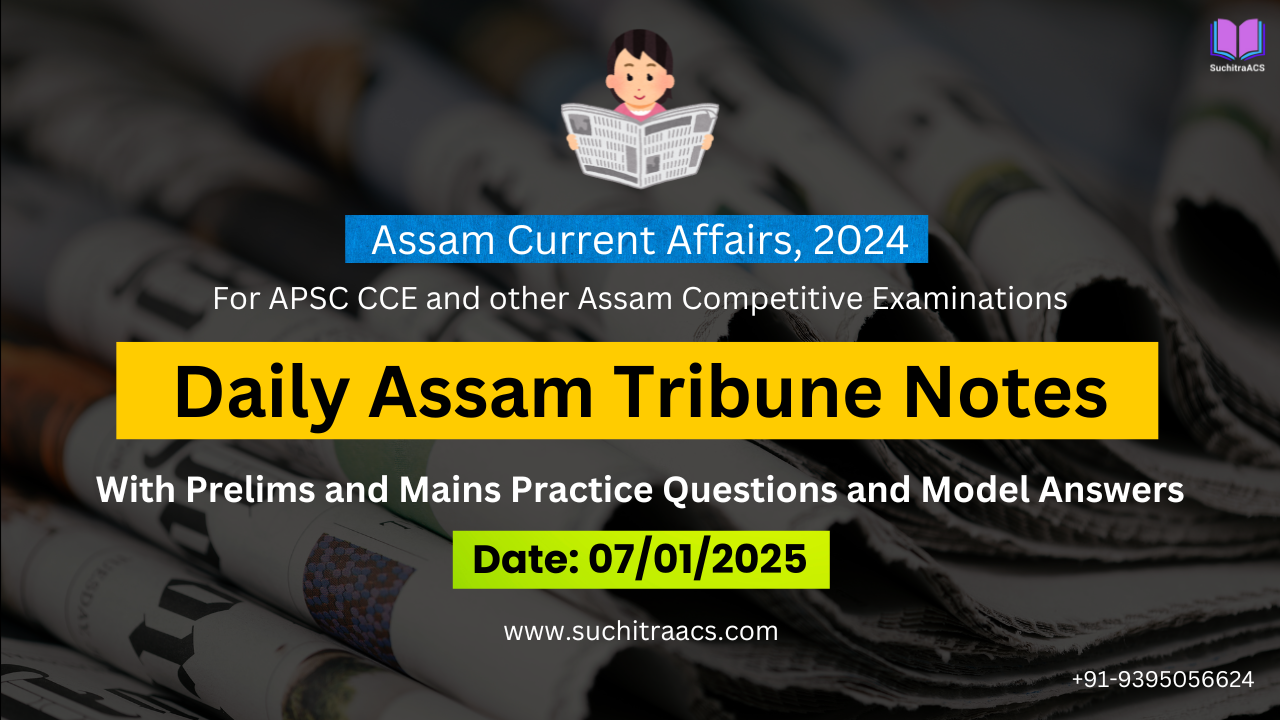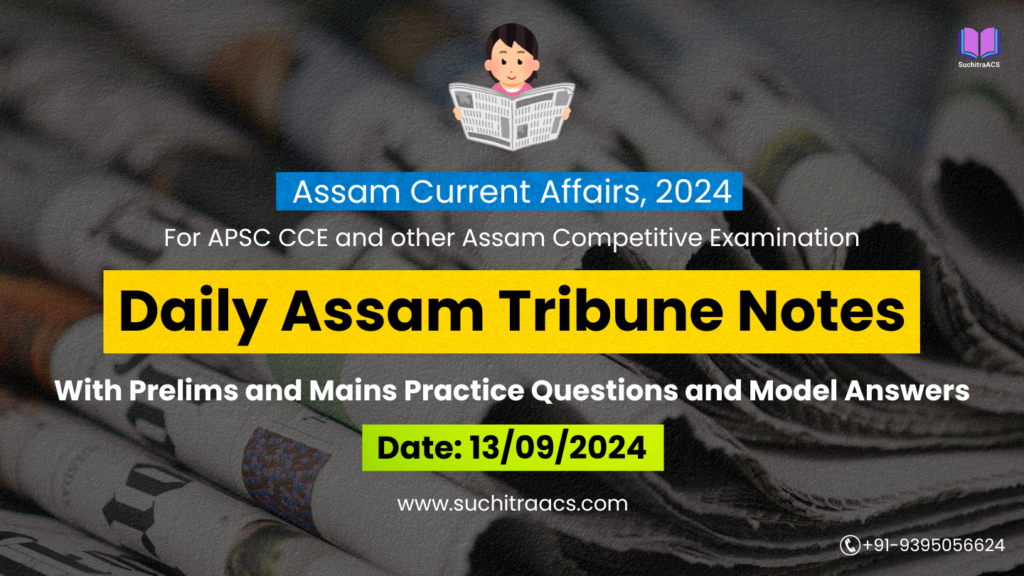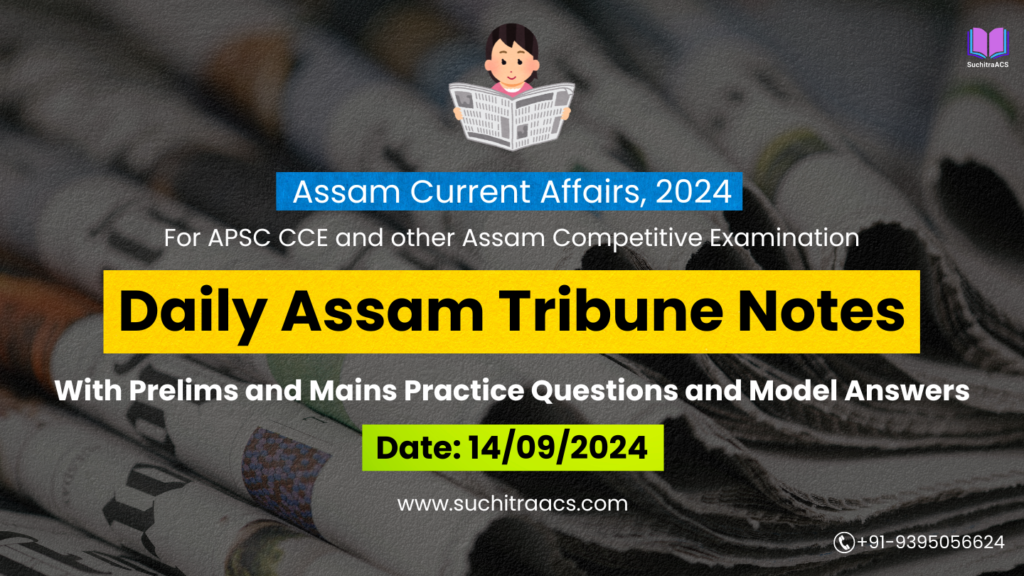APSC Current Affairs: Assam Tribune Notes with MCQs and Answer Writing (07/01/2025)
For APSC CCE and other Assam Competitive examinations aspirants, staying updated with current affairs is vital. This blog covers most important topics from the Assam Tribune today (07-01-2025). These issues are key for both APSC Prelims and Mains preparation, offering insights into the APSC CCE Syllabus.
1. Cowpea Seedlings in Space: ISRO’s CROPS Experiment
GS Paper 3: Science and Technology, Space Technology
Introduction
ISRO has achieved a significant milestone in space-based agriculture through its Compact Research Module for Orbital Plant Studies (CROPS) experiment. Cowpea seedlings have successfully sprouted their first leaves in space aboard the PSLV-C60 POEM-4 module, paving the way for sustainable life support systems in long-duration space missions.
Key Points
- CROPS Experiment Highlights:
- Developed by Vikram Sarabhai Space Centre (VSSC).
- Automated platform designed for plant growth in microgravity.
- Monitors oxygen, carbon dioxide levels, temperature, and soil moisture.
- Significance of Cowpea Growth:
- Demonstrates India’s capability in space-based agriculture.
- Provides insights into plant adaptation in microgravity for future missions.
- Applications in Space Missions:
- Development of food production systems for astronauts.
- Supports regenerative air and water systems critical for human survival in space.
- Future Prospects:
- Expanding experiments to include other crops.
- Research contributes to plans for human exploration of Mars and beyond.
Prelims Pointers
- CROPS Module: Automated plant growth system developed by ISRO.
- Cowpea (Vigna unguiculata): First Indian crop to grow successfully in space.
- PSLV-C60 POEM-4: Mission enabling experiments in space agriculture.
Mains Pointers
Importance of Space-Based Agriculture:
- Sustainability for Space Missions:
- Addresses challenges of food and oxygen production for long-duration missions.
- Reduces dependency on resupply missions from Earth.
- Technological Advancements:
- Showcases India’s progress in bioengineering and space technology.
- Enhances global collaborations in space exploration.
- Scientific Insights:
- Studies plant growth under microgravity conditions.
- Develops knowledge applicable to Earth-based agricultural challenges.
Challenges in Implementation:
- Microgravity Impact:
- Understanding how microgravity affects nutrient uptake and plant growth.
- Technical Constraints:
- Developing systems for energy-efficient agriculture in space.
Way Forward:
- Expand Crop Varieties:
- Include diverse crops to understand growth patterns and adaptability.
- Collaborative Research:
- Partner with international space agencies for joint experiments.
- Earth Applications:
- Apply findings to improve agriculture in challenging environments like deserts.
Conclusion
ISRO’s CROPS experiment marks a significant step in space-based plant research, advancing the goals of sustainable human presence in space. Such innovations not only enable deeper space exploration but also provide solutions to agricultural challenges on Earth.
2. India-Bangladesh Border Management: Progress and Challenges
GS Paper 2: International Relations, Internal Security
Introduction
India and Bangladesh have made significant strides in managing their shared border through enhanced cooperation and infrastructural upgrades. The 4,096-km border, the fifth-longest in the world, remains critical for addressing issues like illegal migration, smuggling, and cross-border crime while promoting legitimate trade and people-to-people ties.
Key Points
- Recent Developments:
- India handed over the Petrapole-Benapole Integrated Check Post expansion to Bangladesh on January 6, 2025.
- Enhanced facilities for customs and immigration at key trade points.
- Economic Significance:
- Petrapole-Benapole accounts for 60% of bilateral trade by land.
- Infrastructure upgrades aim to facilitate faster clearance of goods, boosting regional trade under the BBIN framework.
- Border Security Concerns:
- Persistent challenges of human trafficking, cattle smuggling, and drug trade.
- Militant activities from groups like Ansar Bangla Team (ABT) require vigilant monitoring.
- Cooperative Measures:
- Regular bilateral meetings between India’s BSF and Bangladesh’s BGB (Border Guard Bangladesh).
- Initiatives for joint patrolling and real-time intelligence sharing.
Prelims Pointers
- Petrapole-Benapole Check Post: Largest land port on the India-Bangladesh border.
- BBIN Initiative: Sub-regional cooperation between Bangladesh, Bhutan, India, and Nepal for seamless trade and connectivity.
- Integrated Check Posts (ICPs): Facilities for efficient border management and trade facilitation.
Mains Pointers
Importance of India-Bangladesh Border Management:
- Strengthening Regional Ties:
- Facilitates economic cooperation under India’s “Neighbourhood First” policy.
- Promotes cultural and social exchanges between bordering communities.
- Internal Security:
- Reduces risks of cross-border crimes like smuggling and illegal migration.
- Ensures stability in the Northeast by controlling insurgent movement.
- Economic Growth:
- Expedited trade clearance enhances bilateral trade, contributing to GDP growth.
- Supports local economies by creating job opportunities in border areas.
Challenges:
- Porous Border:
- Difficult terrain makes complete border sealing unfeasible.
- Smuggling and Trafficking:
- Persistent issues with cattle, drugs, and human trafficking.
- Infrastructure Gaps:
- Inadequate roads and facilities in remote border regions.
Way Forward:
- Strengthen Security Infrastructure:
- Deploy advanced surveillance systems like drones and CCTVs.
- Increase the frequency of joint BSF-BGB patrols.
- Enhance Trade Infrastructure:
- Develop more ICPs and modernize existing border facilities.
- Streamline customs and immigration processes.
- Community Engagement:
- Educate border communities on the importance of legal trade and security.
- Foster local development initiatives to reduce reliance on illegal activities.
- Diplomatic Engagement:
- Continue high-level talks to resolve contentious issues like border fencing and river-sharing.
- Promote collaboration under regional frameworks like BBIN.
Conclusion
India and Bangladesh’s border management efforts reflect their commitment to balancing security and economic cooperation. Addressing the remaining challenges requires a mix of technological advancements, local engagement, and sustained bilateral dialogue to ensure a stable and prosperous border region.
3. Indigenous Textiles of Assam: Reviving Heritage Through Modern Markets
GS Paper 1: Indian Culture and GS Paper 3: Economy
Introduction
Assam’s indigenous textile industry, known for its exquisite handloom products like Mekhela Chador and Gamosa, is receiving renewed attention through government schemes and global market outreach. The push aims to preserve traditional weaving techniques while modernizing the industry for economic growth and global recognition.
Key Points
- Unique Features of Assam’s Textiles:
- Mekhela Chador: Traditional women’s attire woven with intricate designs.
- Gamosa: Handwoven cloth symbolizing Assamese identity, now used in home décor and fashion.
- Silk varieties include Muga (golden silk), Eri (peace silk), and Pat silk.
- Government Initiatives:
- Launch of the Assam Handloom Mission to promote exports and modernize production.
- Financial support for weavers through subsidies and interest-free loans.
- Global Market Push:
- Collaboration with fashion houses to integrate traditional motifs into contemporary designs.
- Setting up online marketplaces to reach international buyers.
- Challenges in the Sector:
- Declining number of traditional weavers due to lack of lucrative opportunities.
- Competition from machine-made fabrics undermining the value of handwoven products.
Prelims Pointers
- Muga Silk: GI-tagged golden silk produced only in Assam.
- Eri Silk: Known for its eco-friendly production and use in winter garments.
- Mekhela Chador: Two-piece traditional attire unique to Assam.
Mains Pointers
Significance of the Textile Industry in Assam:
- Cultural Heritage:
- Preserves traditional weaving techniques passed down through generations.
- Promotes Assamese identity on national and global platforms.
- Economic Importance:
- Provides employment to over 13 lakh people, especially women.
- Contributes significantly to the state’s GDP and export revenue.
- Global Potential:
- Increasing demand for sustainable and handmade products in global markets.
Challenges:
- Technological Gap:
- Limited access to modern equipment for weavers in rural areas.
- Market Barriers:
- Poor marketing strategies and limited access to export channels.
- Low Youth Participation:
- Younger generations show declining interest in traditional weaving as a profession.
Way Forward:
- Skill Development Programs:
- Train weavers in digital marketing and modern design techniques.
- Incentivize Weaving:
- Provide better wages and insurance schemes to attract younger weavers.
- Leverage E-Commerce Platforms:
- Promote indigenous textiles through global online marketplaces.
- Cultural Tourism:
- Develop weaving villages as tourist attractions to boost both revenue and awareness.
Conclusion
The revival of Assam’s indigenous textiles represents a harmonious blend of cultural preservation and economic opportunity. By addressing challenges and leveraging modern tools, Assam can position itself as a global leader in sustainable and handcrafted textile products, ensuring the prosperity of its weaving communities.
4. Assam’s Efforts to Combat Drug Trafficking
GS Paper 3: Internal Security and Governance
Introduction
Assam continues to intensify its crackdown on drug trafficking, a significant challenge in the region due to its proximity to the “Golden Triangle” — a major global hub for illicit drug trade. In 2025, the state government has expanded its anti-narcotics operations with a focus on inter-agency coordination, public awareness, and strict enforcement under the Narcotic Drugs and Psychotropic Substances (NDPS) Act.
Key Points
- Recent Developments:
- Over ₹120 crore worth of narcotics seized in operations across Assam in 2024.
- New anti-drug checkpoints established along borders with Nagaland, Manipur, and Arunachal Pradesh.
- Enforcement Actions:
- Deployment of Anti-Narcotics Task Forces (ANTFs) for intelligence-based raids.
- Use of advanced technologies like drug-sniffing drones and AI-driven surveillance for border monitoring.
- Awareness Campaigns:
- Assam Police launched the “Say No to Drugs” initiative targeting schools and colleges.
- Collaboration with NGOs to rehabilitate drug addicts and create support systems.
- Cross-Border Challenges:
- Drug routes from Myanmar and the Golden Triangle remain active.
- Smuggling networks use Assam as a transit point to distribute drugs across India.
Prelims Pointers
- Golden Triangle: An illicit drug-producing region comprising Myanmar, Thailand, and Laos.
- NDPS Act, 1985: Provides the legal framework for combating drug trafficking and abuse in India.
- Anti-Narcotics Task Forces (ANTFs): Specialized units for counter-narcotics operations.
Mains Pointers
Significance of Tackling Drug Trafficking in Assam:
- Public Health:
- Reduces drug abuse and its socio-economic impacts on youth and families.
- Curtails the spread of drug-related diseases like HIV/AIDS.
- Internal Security:
- Weakens organized crime syndicates involved in trafficking.
- Prevents the funding of insurgent groups through drug trade profits.
- Economic Benefits:
- Saves resources spent on healthcare and law enforcement related to drug abuse.
- Strengthens investor confidence by ensuring a safe and secure business environment.
Challenges:
- Porous Borders:
- Difficult terrain and lack of infrastructure make border security challenging.
- Sophisticated Smuggling Networks:
- Use of advanced methods like hidden compartments in vehicles.
- Limited Rehabilitation Facilities:
- Inadequate support for recovering addicts.
Way Forward:
- Strengthen Border Security:
- Enhance patrols and deploy advanced surveillance systems like drones.
- Inter-Agency Coordination:
- Improve collaboration between Assam Police, NCB, and international bodies.
- Expand Rehabilitation Programs:
- Build more drug de-addiction centers and train counselors.
- Community Participation:
- Involve civil society and local leaders in awareness campaigns and intelligence gathering.
Conclusion
Assam’s comprehensive approach to combating drug trafficking reflects its commitment to securing its borders, safeguarding public health, and curbing organized crime. By integrating enforcement, rehabilitation, and awareness, the state can effectively mitigate this pressing challenge and foster a safer society.
APSC Prelims Practice Questions
Topic 1: Cowpea Seedlings in Space: ISRO’s CROPS Experiment
- Which of the following statements about ISRO’s CROPS experiment is correct?
- (a) It focuses on monitoring the impact of microgravity on human physiology.
- (b) It is India’s first experiment to successfully grow cowpea seedlings in space.
- (c) It is a project under Gaganyaan focusing on astronaut training.
- (d) It aims to establish satellite-based precision agriculture systems.
Answer: (b)
Explanation:
The CROPS experiment demonstrated India’s capability to grow cowpea seedlings in space, marking a significant step in space-based agriculture.
- Which of the following crops was the first Indian plant to grow in space under ISRO’s CROPS experiment?
- (a) Wheat
- (b) Cowpea
- (c) Rice
- (d) Millets
Answer: (b)
Explanation:
Cowpea (Vigna unguiculata) was the crop grown successfully aboard the PSLV-C60 POEM-4 module.
- The CROPS experiment is associated with:
- (a) Human physiological studies in space.
- (b) Plant growth under microgravity conditions.
- (c) Water recycling systems for astronauts.
- (d) Remote sensing applications in agriculture.
Answer: (b)
Explanation:
The experiment focuses on plant adaptation and growth in microgravity to develop sustainable food production systems in space.
Topic 2: India-Bangladesh Border Management
- Which border check post accounts for the majority of India-Bangladesh trade by land?
- (a) Agartala-Akhaura
- (b) Petrapole-Benapole
- (c) Dawki-Tamabil
- (d) Sutarkandi-Sylhet
Answer: (b)
Explanation:
The Petrapole-Benapole check post handles 60% of India-Bangladesh bilateral trade via land.
- The BBIN initiative aims to:
- (a) Resolve border disputes among member nations.
- (b) Enhance trade and connectivity between Bangladesh, Bhutan, India, and Nepal.
- (c) Establish a free trade zone in South Asia.
- (d) Strengthen defense cooperation among member nations.
Answer: (b)
Explanation:
The BBIN initiative facilitates seamless trade, connectivity, and cooperation among Bangladesh, Bhutan, India, and Nepal.
- What is the role of Integrated Check Posts (ICPs) along the India-Bangladesh border?
- (a) Strengthening military defense at border areas.
- (b) Facilitating efficient trade and border management.
- (c) Monitoring climate and environmental changes.
- (d) Establishing refugee shelters during emergencies.
Answer: (b)
Explanation:
ICPs streamline trade and border management by integrating customs, immigration, and other facilities at a single point.
Topic 3: Indigenous Textiles of Assam
- Which type of silk is unique to Assam and holds a GI tag?
- (a) Mulberry Silk
- (b) Tussar Silk
- (c) Muga Silk
- (d) Eri Silk
Answer: (c)
Explanation:
Muga silk, known for its natural golden color, is exclusively produced in Assam and has a GI tag.
- The Mekhela Chador is best described as:
- (a) A traditional Assamese fabric made from jute.
- (b) A two-piece attire for Assamese women.
- (c) A handwoven scarf symbolizing Assamese culture.
- (d) An eco-friendly winter garment made from Eri silk.
Answer: (b)
Explanation:
Mekhela Chador is a traditional two-piece women’s attire unique to Assam.
- Which initiative has been launched to modernize Assam’s handloom sector?
- (a) Assam Textile Revival Scheme
- (b) National Silk Development Mission
- (c) Assam Handloom Mission
- (d) India Artisans Promotion Scheme
Answer: (c)
Explanation:
The Assam Handloom Mission focuses on modernizing production, promoting exports, and supporting weavers.
Topic 4: Assam’s Efforts to Combat Drug Trafficking
- Which region is referred to as the “Golden Triangle” in the context of drug trafficking?
- (a) India, Nepal, and Bhutan
- (b) Myanmar, Thailand, and Laos
- (c) India, Myanmar, and Bangladesh
- (d) Afghanistan, Pakistan, and India
Answer: (b)
Explanation:
The “Golden Triangle” comprises Myanmar, Thailand, and Laos, known for being a major hub of illicit drug production.
- Which law provides the legal framework for combating drug trafficking in India?
- (a) Unlawful Activities Prevention Act (UAPA)
- (b) Narcotic Drugs and Psychotropic Substances (NDPS) Act
- (c) Prevention of Illicit Traffic in Narcotic Drugs Act
- (d) Criminal Law Amendment Act
Answer: (b)
Explanation:
The NDPS Act, 1985, provides the legal framework for controlling drug trafficking and abuse in India.
- What is the primary role of the Anti-Narcotics Task Forces (ANTFs)?
- (a) Regulating pharmaceutical industries.
- (b) Conducting intelligence-based counter-narcotics operations.
- (c) Monitoring international trade agreements.
- (d) Creating public awareness about cybercrime.
Answer: (b)
Explanation:
ANTFs are specialized units that conduct intelligence-based operations to combat drug trafficking.
APSC Mains Practice Question
Q. Examine the significance of ISRO’s CROPS experiment in advancing space-based agriculture and its potential implications for sustainable space exploration and Earth-based agricultural challenges.
Model Answer
Introduction
ISRO’s Compact Research Module for Orbital Plant Studies (CROPS) experiment successfully demonstrated the growth of cowpea seedlings in space aboard the PSLV-C60 POEM-4 module. This marks a significant achievement in space-based agriculture, providing insights into plant adaptation in microgravity.
Significance of the CROPS Experiment
- Sustainability for Space Missions:
- Food Production: Enables astronauts to cultivate fresh food on long-duration missions, reducing dependency on Earth-based resupply missions.
- Life Support Systems: Plants contribute to oxygen generation and carbon dioxide absorption, vital for maintaining closed-loop systems in space.
- Scientific Advancements:
- Understanding plant physiology in microgravity enhances knowledge of nutrient uptake, growth patterns, and stress responses.
- Paves the way for developing energy-efficient and automated agricultural systems suitable for space environments.
- Exploration Goals:
- Supports India’s ambitions for Mars and lunar missions by establishing self-sustaining ecosystems.
- Demonstrates India’s capacity for innovation in space technology and strengthens global collaborations.
- Earth-Based Applications:
- Findings can be applied to improve agricultural practices in extreme environments like deserts, high altitudes, or disaster-prone areas.
- Advances in bioengineering and precision farming tools benefit global food security.
Challenges in Space-Based Agriculture
- Microgravity Impact:
- Understanding how microgravity affects water and nutrient transport within plants remains a challenge.
- Technical Constraints:
- Developing systems that are energy-efficient and compact for use in confined spaces like spacecraft.
- Cost:
- High initial investments in research and development for space-based systems.
Way Forward
- Expand Crop Research:
- Experiment with other crops to understand adaptability and productivity in space.
- International Collaboration:
- Partner with global space agencies like NASA and ESA for joint agricultural research and resource sharing.
- Focus on Technology Development:
- Invest in advanced technologies like 3D bioprinting and AI-based monitoring systems for agricultural automation in space.
- Application to Earth Agriculture:
- Use findings to develop climate-resilient crops and improve farming practices in areas with scarce resources.
Conclusion
ISRO’s CROPS experiment is a significant milestone in space technology, reflecting India’s leadership in innovative research. By addressing challenges and expanding research, space-based agriculture can ensure sustainability in extraterrestrial exploration while offering solutions to pressing agricultural challenges on Earth.
✨ APSC Prelims Crash Course, 2025
at most affordable rate in Assam!

🔔 Join Our WhatsApp Study Group!
For exclusive access to premium quality content, including study materials, current affairs, MCQs, and model answers for APSC CCE and other Assam competitive exams.
Click here to join: SuchitraACS Study WhatsApp Group
📚 Want to know more about SuchitraACS’s most affordable courses?
Click here to know more: SuchitraACS Courses for APSC CCE and Assam Competitive Examinations




